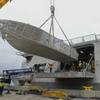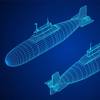The Military Sealift Command (MSC) hospital ship, USNS Mercy (T-AH 19) pulls into Pearl Harbor for a scheduled port visit. Mercy is making its first stop during a humanitarian assistance mission to the Western Pacific and Southeast Asia. U.S. Navy photo by Photographer's Mate 2nd Class Justin P. Nesbitt
U.S Naval hospital ship USNS Mercy (T-AH 19) arrived here May 2, making its first stop during a humanitarian assistance mission to the Western Pacific and Southeast Asia.
This deployment to the region exemplifies the U.S. commitment to South and Southeast Asia and the Pacific island nations while building upon relationships established during Operation Unified Assistance in 2005.
Meeting the arriving ship at the pier, Adm. Gary Roughead, commander, U.S. Pacific Fleet, told members of the media and Mercy crew members that accomplishing the mission will be all about teamwork.
“This is about a partnership,” said Roughead. “The capability that Mercy brings as a hospital ship is really unequalled. She has tremendous medical capabilities, and it is our pleasure to be able to couple that medical capability and our military medical professionals with the non-governmental organizations (NGO) and the host nations’ medical capability to bring medical service, preventive medical service and just the good work people bring to one another.”
Roughead’s comments were echoed by Drs. Ramon K. Sy and Carl H. Lum, of the Aloha Medical Mission based in Hawaii.
“We are most honored to be invited by the U.S. Navy to join in this humanitarian work,” said Sy. “It’s very exiting for us. I will personally be going to Banda Aceh in July. We will help rebuild the hospital in the area that was devastated by the tsunami,” Sy added.
“Over a year ago, Aloha Medical Mission sent two teams to Banda Aceh after the tsunami, and I was standing in knee-deep mud. When I looked out, there was Mercy there,” said Lum. “I said, 'I wish I could be doing surgery on the Mercy instead of in a tent with a mud floor.' So I didn’t know that a year later, I will have that opportunity to serve on the Mercy.”
The commander of Mercy’s overall mission is Capt. Bradley Martin. Capt. Joseph L. Moore is in command the ship’s medical treatment facility and its medical staff. In charge of the ship and its crew is civil service mariner Capt. Robert T. Wiley, ship’s master.
The ship and crew of doctors, dentists, veterinarians, nurses, and corpsmen plan to offer a number of medical, dental and veterinary services and other humanitarian assistance to men, women and children in villages normally lacking access to such treatment.
“Many Americans are from the Asia-Pacific region, and we have strong ties to family members, friends and co-workers with roots in the region,” said Roughead. “It is natural we should want to be good neighbors.”
Like all naval forces, Mercy can rapidly respond on short notice to a wide range of humanitarian missions or other crises. The deployment offers the Navy the opportunity to train the ship’s crew, medical staff and nongovernmental organization partners for future operations.
“By deploying Mercy, we’re not only providing support to the host nations, we are training our medical crew in order to better prepare them to respond in times of disaster relief,” said Roughead.
“We can provide a wide range of medical care from dental, optometry, surgery, general surgery and pediatric care, just to name a few,” said Capt. Joseph L. Moore, military treatment facility commander.
Working in cooperation with host nations, Mercy medical staff will provide these medical and dental assistance programs ashore and afloat.
In addition to the Navy medical assets deploying with Mercy, the ship is also serving as an enabling platform for numerous embarked NGOs, such as the Hawaii-based Aloha Medical Mission.
The relationships with non-governmental agencies developed in the relief efforts following the tsunami in December 2004 were key to developing a new standard for cooperation between the U.S. military and NGOs, in order to serve a common goal of bringing humanitarian assistance to communities in need.
After assisting with the tsunami relief effort, Mercy followed up by performing Operation Unified Assistance. During that mission, Mercy’s medical team treated 107,000 patients, performed 466 surgeries, distributed 11,555 pairs of eyeglasses and performed more than 6,900 dental procedures.
Mercy’s deployment is expected to last about five months.
Source: From Commander, U.S. Pacific Fleet Public Affairs
Subscribe for
Maritime Reporter E-News
Maritime Reporter E-News is the maritime industry's largest circulation and most authoritative ENews Service, delivered to your Email five times per week










